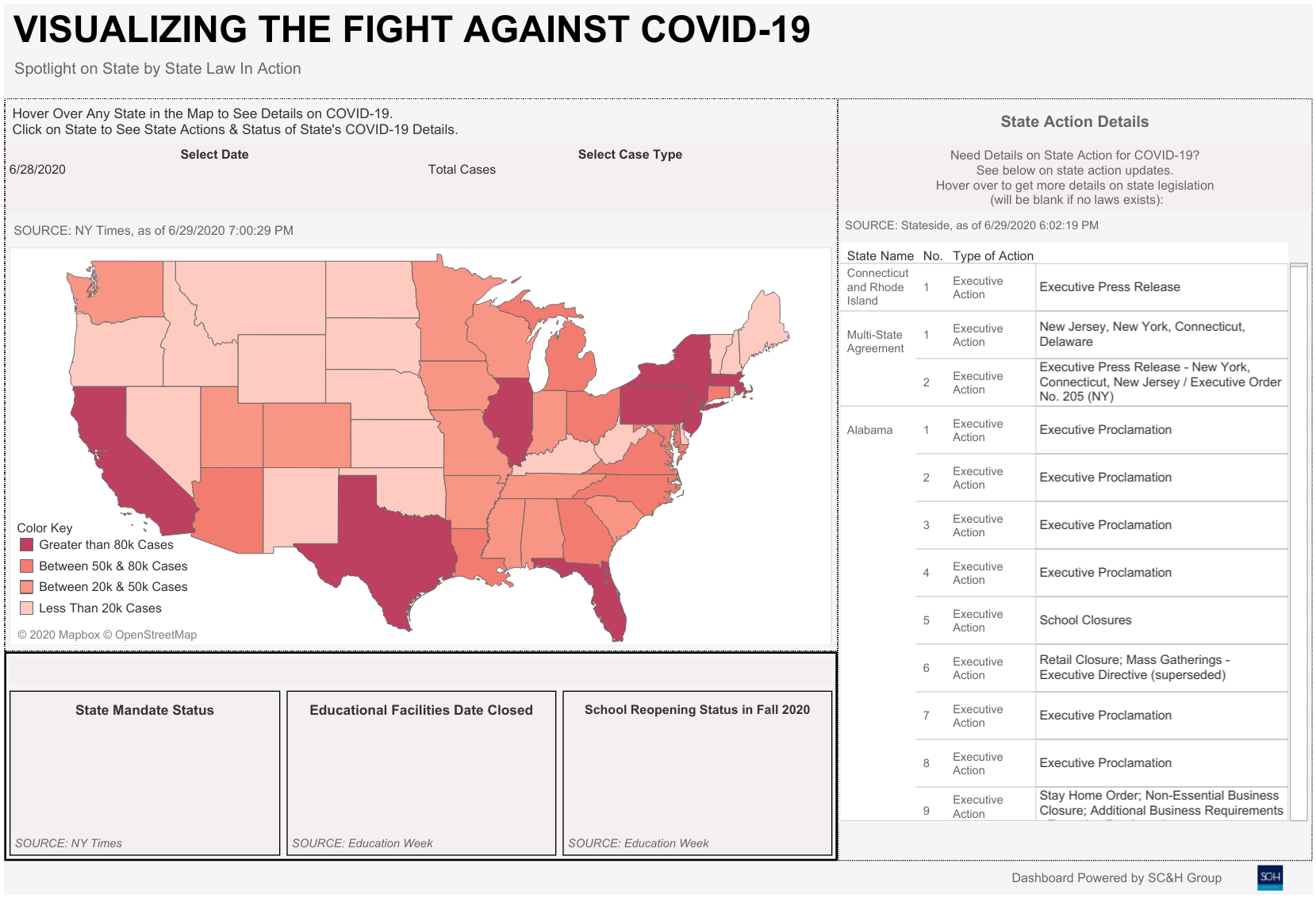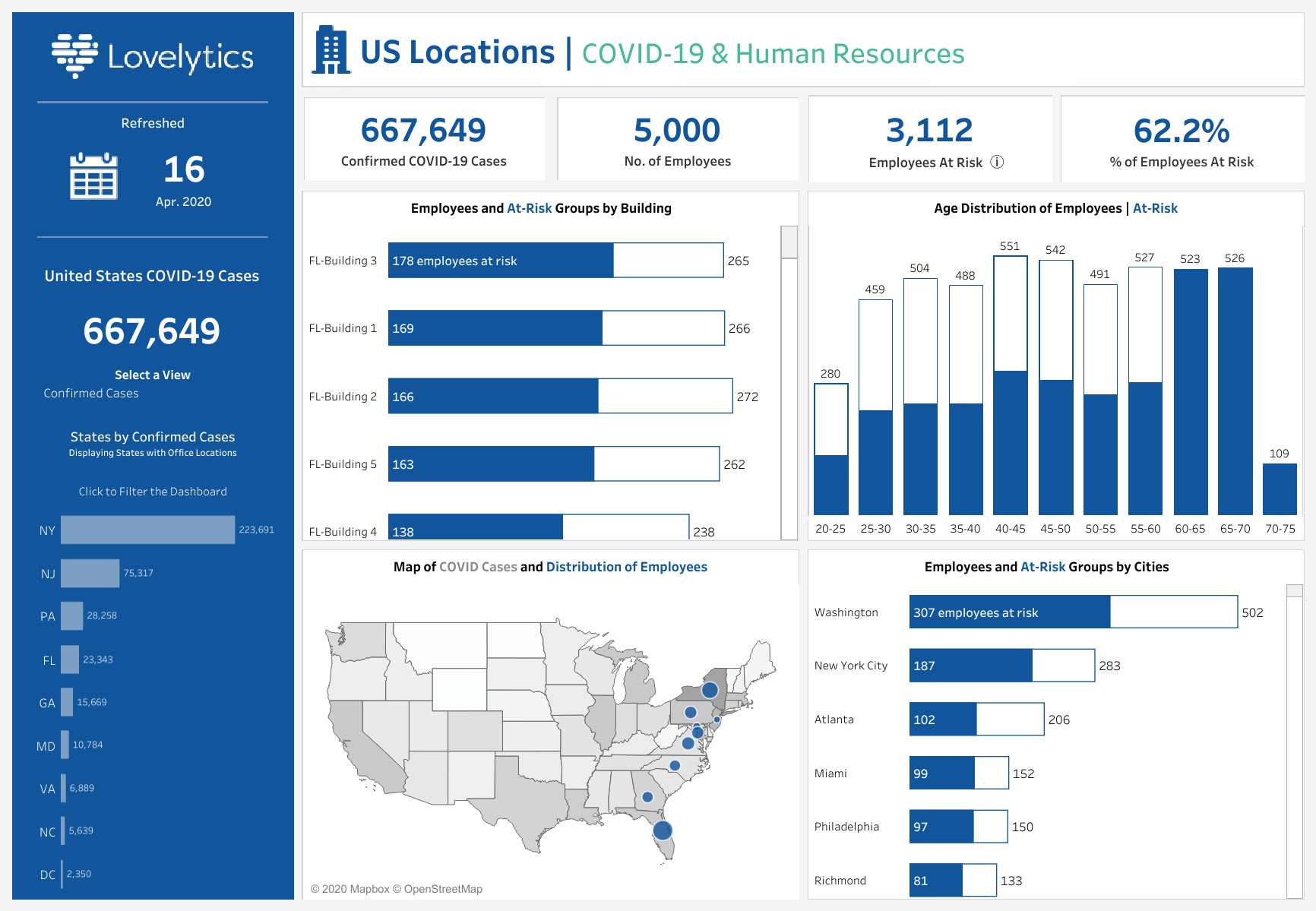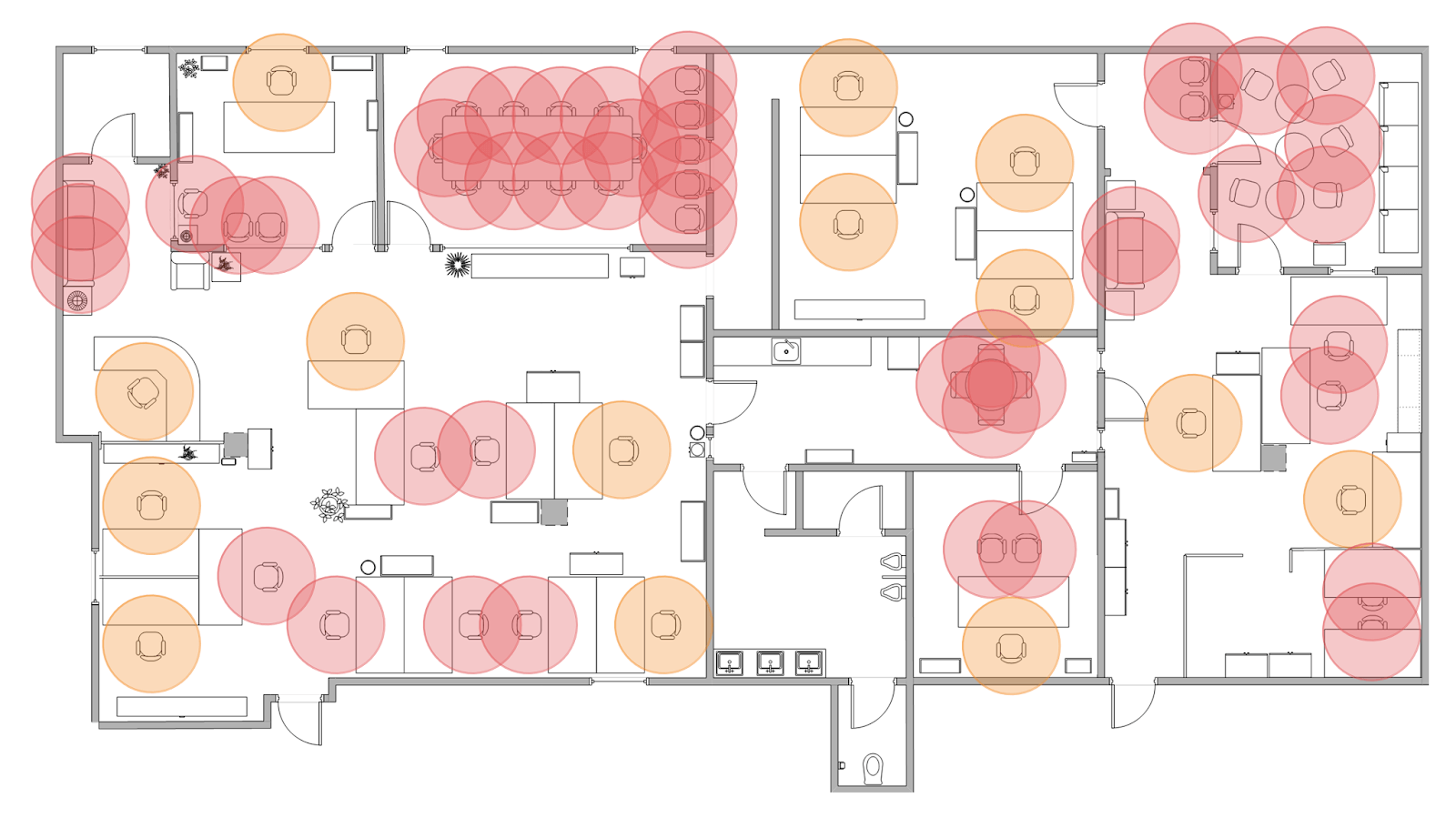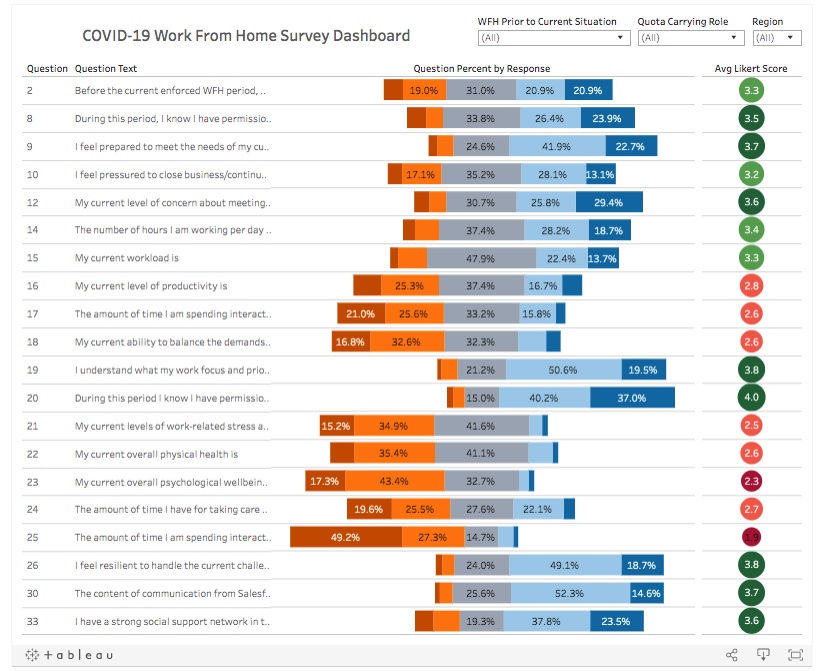Workplaces are reopening in the face of COVID-19. Here’s four areas to consider in your workplace data strategy
COVID-19 has forced organizations to rethink the future of physical workspaces. Everything from desk layouts to conference rooms to communal areas need to be approached with a new lens of employee health and safety. Data plays a critical role in how leaders structure their reopening plans, identify metrics for reopening, and measure effectiveness.
Some countries are already reopening offices as the rest of the world watches and learns. One of the biggest learnings from the Asia Pacific region so far, as Gartner suggests, is the importance of “transparency” and “iteration.” As Hernan Asorey, Chief Data Officer at Salesforce explained, “We are always assessing the data we have available to make decisions. For every evolving need, we pragmatically look at what exists from trusted sources, we vet it with experts in the field, and then we assess, augment, learn and adapt."
Since organizations are faced with entirely new challenges—all dependent on a variety of factors including office location, workspace type, and workforce size—leaders need data to inform a flexible approach to planning.
This blog post covers four areas where data can help inform your reopening strategy:
- Creating a COVID-19 task force
- Tracking regional policies
- Informing workspace planning
- Analyzing employee survey data
These areas represent a starting point and not an exhaustive list. Since all of these details vary based on your organization, please use this blog post for informational purposes only. For detailed solutions on how to reopen your workplace safely and efficiently, explore Work.com by Salesforce.
1. Create a COVID-19 task force, backed by data
Reopening is a cross-functional effort. Organizations are instituting centralized, assigned COVID-19 task forces—made up of a variety of people with a diverse set of skills and perspectives—to manage details like workplace logistics and employee communications. In Salesforce’s guide, How to Reopen Your Business, Elizabeth Pinkham, EVP of Global Real Estate at Salesforce noted the importance of having this group represent your workforce as a whole.
“At Tableau, we’re bringing together a variety of stakeholders into workplace conversations,” said Debbie Smith, Senior Manager of Workplace at Tableau. “We have perspectives—and data—from all aspects of the company, from security to HR to real estate to marketing to procurement. We’re also bringing in outside experts to inform details like capacity planning and air filtration.”
All of these stakeholders work with different data points to inform their perspectives. For example, health and safety teams might monitor regional policy data, procurement might use data to inform any new equipment purchases, like panels between desks, while IT might work with workplace teams to determine how to replace existing equipment like phones or headsets.
Creating a dedicated team is a foundational step in a reopening strategy, because data is only useful when people can provide context and take action.
2. Track regional policy data to inform reopening
Reopening strategies are largely dependent on local policies. In addition to these policies, organizations are also faced with a long list of guidance from the Occupational Safety and Health Administration (OSHA), the Center for Disease Control and Protection (CDC), the Environmental Protection Agency (EPA), and more.
Organizations are exploring centralized dashboards to track changing policies and to inform key indicators to determine when it is safe to reopen offices. The SC&H Group's Data Analytics Team, for example, created a sample dashboard that shows what this could look like for a company in the United States. The dashboard highlights legislation on a state-by-state basis alongside a map showing number of cases.

Sample dashboard from managing consulting group, SC&H Group that displays local policy data alongside regional case data.
Christopher Adolph, associate professor of political science and adjunct associate professor of statistics at the University of Washington, is curating and maintaining a data set on state policies related to COVID-19 from open source data. He encourages data and analytics leaders to take a focused approach when visualizing local policy data. That might mean considering other visualization types beyond maps to focus on specific, regional metrics that show the impact of COVID-19.
“If I were an organization,” shares Christopher, “I would structure a visualization to show what’s happening in each location associated with my business, with filters that allow stakeholders to sort through stringency of policies, trends in mobility, and trends in cases. I would want to see a time series of how policies change over time as cases increase or decrease in a region.”
A Tableau Partner Lovelytics created another dashboard template combining data from the Tableau COVID-19 Data Hub with sample HR data, providing a breakdown of at-risk employees by building, age group, and location. Although this example was originally developed for companies looking to stabilize in a crisis, these types of dashboards could also become a single source of truth in the event of another wave of the virus after reopening.

Tableau partner, Lovelytics, created a COVID-19 and human resources dashboard solution to analyze risk by location.
3. Inform workspace planning, including desk layouts and density
Some of the most complex challenges that employers face in the wake of COVID-19 are related to workspace layouts. Many organizations have adopted open office concepts, making it difficult to enforce six-feet guidance between employees. They’re also evaluating the use of shared spaces like kitchens, bathrooms, and elevators along with high-end air filtration systems to reduce the spread of infectious droplets. One way that employers can start to make sense of all of these logistical decisions is through data.
Some key data points that employers are collecting (or considering collecting) around space utilization are:
- Physical distance (between desks and in shared spaces)
- De-densification (removing furniture in communal spaces like kitchens and conference rooms)
- Air movement and ventilation
- Pinch points like elevators and bathrooms
These new challenges are leading organizations to take a new approach to workplace metrics. Salesforce, for example, is analyzing data to model staggered arrival times so they can effectively manage elevator capacity. “The last thing we want is employees waiting too long for elevators and backing up into the lobbies and out onto the sidewalks,” shared Elizabeth Pinkham. Salesforce is also partnering with Siemens on key solutions for a ‘touchless office,’ where organizations can manage occupancy and location data to augment their contact tracing process (on an opt-in basis).
Global commercial real estate services firm Cushman & Wakefield noted in its Recovery Readiness guide that organizations may want to “invest in operational building technologies that enhance the integration, visibility, and control of building and workplace systems” (like occupancy sensors or air quality monitoring capabilities). The company also piloted a new office layout in Amsterdam deemed “The 6-Feet Office,” using large circles and visual cues to enforce a six-foot separation between employees.

An example dashboard from Tableau Zen Master Ken Flerlage. Note that this is intended to be an example and not a template. There are a variety of factors in workplace planning that organizations need to consider beyond the six-feet guideline.
Recently, Tableau Zen Master Ken Flerlage explored what an office space visualization could look like, drawing six-feet circles around each desk. If a desk area doesn’t follow the six-foot perimeter, then the circle turns red and indicates that the company needs to rethink the layout of that office area. In Ken’s blog post about the visualization, Amanda Makulec, Data Visualization Lead at Excella and Bridget Cogley, Senior Consultant at Teknion explain that this template is a good starting point for people as they rethink office seating arrangements, but that there needs to be additional thinking around the complexities of how people move in an office setting.
To account for these complexities, some companies are hiring external experts to help set these parameters and inform logistics planning. All of these concepts will require additional iteration and flexibility as organizations put them into practice.
4. Analyze survey data about employee mental health and wellness
Whether or not they can physically return to work, organizations also need to think about employee needs. Are employees comfortable returning to work—and if so, in what capacity? Some employees need to stay home with kids as schools remain closed, others may have compromised immune systems, and some may just be more comfortable working from home until a vaccine is available to the public.
Some companies, including Tableau, are gauging employees’ concerns through regular surveys. They’ll ask questions about general wellbeing, like how they’re adapting to work-from-home and how the company can support them. Companies in the logistical planning stages might ask questions about whether or not employees are comfortable returning to work to determine reopening schedules.

An example dashboard from the Tableau people analytics team showing results of a COVID-19 work-from-home survey (this dashboard contains sample data).
With this data at their fingertips, organizations can analyze:
- Mental health benchmarks
- Employee feedback to inform reopening schedule
- Employee needs like office equipment or childcare support services
Once offices reopen, companies could join this survey data with utilization data to understand how many employees are actually coming into the office on a regular basis. This can help inform whether or not employees are comfortable with new working conditions. Since organizations will need to stagger shifts, start times, and break times, this data can also serve as a reference point for shift planning.
Analyzing the results of these surveys can help organizations develop important metrics around how the pandemic is affecting their employee base and help them determine how to take action.
Learn more about COVID-19 and workplace data
Data can be a powerful resource as organizations face unprecedented decisions about workplace reopening. But with health and safety at risk, organizations should equally invest in the development of the people analyzing this data and seek advice from outside experts to guide their path when necessary.
Explore additional COVID-19 resources:
- Explore industry-specific data tracks and jumpstart your own analysis with downloadable workbooks from the COVID-19 Data Hub.
- Work.com by Salesforce provides you with essential solutions designed to help businesses reopen workplaces safely and efficiently.
- Read Salesforce’s step-by-step guide for returning to the office from Elizabeth Pinkham, Executive Vice President of Global Real Estate.
相關文章
Subscribe to our blog
在收件匣中收到最新的 Tableau 消息。








